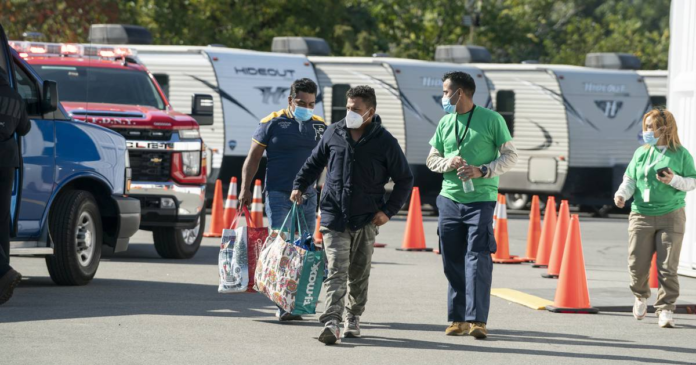Mayor Adams is opening the door once again to the possibility of housing asylum seekers on cruise ships — his latest response to the migrant crisis that’s so far cost the city an estimated $300 million.
Adams, who spoke Wednesday morning in an interview broadcast by Politico, said “there is no more room” to house the thousands of migrants who began flooding into New York City last year and that his “guesstimate” on the cost of the city’s projected total response would come with a price tag of $2 billion.
Advertisement
But he noted that in spite of that the city would continue to look for ways to accommodate migrants coming to the U.S. from south of the border.
Mayor Eric Adams (Shawn Inglima/for New York Daily News)
“We’re continuing to pivot and shift as needed. And if it means using cruise ships, if it means finding space on state land in my conversations with the governor, we’re going to continue to pivot and shift to address the influx of migrants and asylum seekers that we’re seeing. Nothing is left off the table,” he said. “Every item is on the table because we have a moral and legal responsibility to do what’s right for not only all New Yorkers, but whoever comes to our city.”
Advertisement
The city estimates that about 40,000 asylum seekers have come to the city over the last year, causing its social services infrastructure to buckle under the burden. For weeks, Adams has said that strain has reached its breaking point and that it’s time for the federal government to do more to address the situation.
As the crisis first began coming to light last year, migrants who were bussed in from Texas and other border states were referred to the city’s shelter system. As the shelters began to fill up, the city floated the idea of using cruise ships to house them. That didn’t come to pass, and the city instead relied on emergency units in hotels to house the migrants.
“We think there must be a long-term and a short-term plan. The long-term plan is Congress. Congress has an obligation to come up with real comprehensive immigration reform. That’s the long-term plan. That does not solve our immediate crisis,” he said Wednesday.
Three male migrants arrive at Randall’s Island Humanitarian Emergency Response and Relief Center in a city passenger van Thursday, October 20, 2022 in Manhattan, New York. (Barry Williams/for New York Daily News)
In the shorter term, Adams said President Biden should continue to use a decompression strategy, which relies on the feds turning some asylum seekers away at the border while they wait for their asylum applications to be reviewed.
Speaking later in the day at the U.S. Conference of Mayors, Adams praised the Biden administration’s “bold” vision for tackling the migrant crisis through legislative reforms and immigration laws, and blamed Republicans in Congress for blocking it.
“Every attempt to deal with this immigration on a national level through legislation has been sabotaged, mostly by right-wing opposition, and cities are bearing the brunt of this failure,” he said.
The embrace of Biden’s migrant approach marked a contrast to months of laments from Adams about the feds not doing enough to help New York City, including accusing them of creating “this mess.”
Around 60 recently arrived Venezuela migrants are seen being dropped by an MTA Bus at a shelter at Bellevue on Oct. 12, 2022. (Luiz C. Ribeiro/for New York Daily News)
A day earlier, Adams called for the appointment of a “national czar” to sort out the crisis, which is not only being felt in New York City, but also in Chicago, Washington and El Paso, Texas. He did that in spite of the fact that Vice President Kamala Harris has already been tasked with that responsibility.
Advertisement
On Wednesday, in what appeared to be an attempt to clarify his remarks, Adams said that czar should be someone “whose sole responsibility” is overseeing the federal government’s handling of the crisis.
That recommendation is the first part of a six-point plan Adams floated for how the federal government should help cities tackle the migrant crisis.
That plan, he said, should also include Congress allocating more financial aid for cities through the Federal Emergency Management Agency, and border authorities devising a strategy that ensures “fair” placement of migrants across the country — as opposed to the burden disproportionately falling on a handful of large cities.
“Cities and mayors have gotten us this far,” he said. “Now it’s time for our entire government to support the work.”




